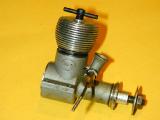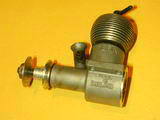| Name | Elfin 149 | Designer | Aerol Engineering |
| Type | Compression Ignition | Capacity | 1.49cc |
| Bore | .503" | Stroke | .460" |
| Production run | Lots | Country of Origin | UK |
| Photo by | Ron C | Year of manufacture | 1950..59 (?!) |
Background:
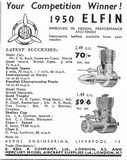 Page back through Aermodeller of the 1950's and you'll see that the Elfin 149 was sweeping the field for free flight power models in its class (the capacity limit for the class was 1.51cc, so you can see why manufacturers were careful to specify their engines just under the limit). The Elfin range was produced by Aerol Engineering Pty Ltd of Henry Street, Liverpool, England during the 1950's. They made the most delightful, lightweight plain bearing engines of capacity 1.8cc, 1.49cc and 2.49cc, and a corresponding series of twin ball race engines that some would assert are remarkably ugly and overweight--sort of like a plumber's T fitting with a prop at the front.
Page back through Aermodeller of the 1950's and you'll see that the Elfin 149 was sweeping the field for free flight power models in its class (the capacity limit for the class was 1.51cc, so you can see why manufacturers were careful to specify their engines just under the limit). The Elfin range was produced by Aerol Engineering Pty Ltd of Henry Street, Liverpool, England during the 1950's. They made the most delightful, lightweight plain bearing engines of capacity 1.8cc, 1.49cc and 2.49cc, and a corresponding series of twin ball race engines that some would assert are remarkably ugly and overweight--sort of like a plumber's T fitting with a prop at the front.
The engine described here appeared on the British market in 1950. It was Aerol's second product, the first having been the radial mount 1.8cc plain bearing. Aeromodeller carried a review of it their June 1950 issue (the same one that featured the Bristol Brabazon) [1]. This review was number 24 in the engine test series conducted for them by Laurence Sparey. He reported that the engine produced 0.10 BHP at 13,700 RPM. The tests published by rival publication Model Aircraft (not credited, but probably conducted by Peter Chinn) claimed 0.13 BHP at 1300 RPM [2].
Versions:
Establishing how many were made is always difficult. The serial number on mine is 5757 and is prefixed with "59" (see the end of the right lug in the photo above). This may indicate that the engine was made in 1959, however OFW Fisher states that all Aerol production ended in 1958 [3]. Be it '58 or '59, that's one hell of a production life for one design. And as we shall see, one which has been extended again, and then again. The engine pictured above is an original Aerol version, but Australian icon and fully certified eccentric, Mr Ivor F (that's his correct surname: "F" -- no full stop, no nothing; it's a long story) brought new life to the design in the 1990's with a reproduction.
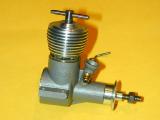 Superficially, they look the same. But a close examination will reveal enough differences that there can never be any mistaking one for the other. Some parts for the reproduction were contracted by Ivor to a Russian company; others were made by a group of people in Australia. Assembly and fitting was carried out with great care and attention to detail by Ivor. His engines came with an ownership certificate and carry his serial number sequence. Ivor produced version with a conventional steel liner with a lapped cast iron piston and an ABC (aluminium piston in a chromed, brass liner) variant. While these are all long gone, the Russian company continues to make a few of both types.
Superficially, they look the same. But a close examination will reveal enough differences that there can never be any mistaking one for the other. Some parts for the reproduction were contracted by Ivor to a Russian company; others were made by a group of people in Australia. Assembly and fitting was carried out with great care and attention to detail by Ivor. His engines came with an ownership certificate and carry his serial number sequence. Ivor produced version with a conventional steel liner with a lapped cast iron piston and an ABC (aluminium piston in a chromed, brass liner) variant. While these are all long gone, the Russian company continues to make a few of both types.
Looking at the two photos which show the engine from the right, we see that the "149" is enclosed in an oval embossing on the original while the repro omits this detail. Next, notice the large number of very thin, closely spaced fins on the original, 13 in number; those on the repro are thicker, numbering only nine. Notice too the serial number on the right lug of the original and the way the lug front is square and flush with the case cavity while the lugs on the repro finish back from the bulge and have a rounded front edge. There is a pronounced difference in the prop drivers and the brass liner of the ABC engine is obvious, once you know to look.
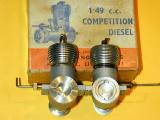 The rear view shows considerable difference in the backplate with the original being designed for a pin-spanner, while the repro has a "coin slot" arrangement. Not as obvious as I'd hoped in this shot is the wrist pin retention. The repro engine pin is staked into the piston while that in the original is fully free floating (it does have a much greater diameter than the exhaust port slot, but the transfer ports could cause a problem here). This photo also shows that the height of the repro is greater than the original, and again, the brass liner stands out. The box behind is an original.
The rear view shows considerable difference in the backplate with the original being designed for a pin-spanner, while the repro has a "coin slot" arrangement. Not as obvious as I'd hoped in this shot is the wrist pin retention. The repro engine pin is staked into the piston while that in the original is fully free floating (it does have a much greater diameter than the exhaust port slot, but the transfer ports could cause a problem here). This photo also shows that the height of the repro is greater than the original, and again, the brass liner stands out. The box behind is an original.
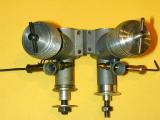 From the top, the differences are quite apparent in the mounting lugs, mounting hole spacing and prop driver boss. Detail on the needle valve differs and the original carries a music-wire friction device, as well as being slit to close-up the thread; the repro is knurled and is slit only. The different length overall is apparent, but not apparent is the screwed in stud for the prop nut on the repro--the original following common practice for the time, is integral with the shaft. I much prefer the stud feature on a working engine as a "crash-survival" precaution.
From the top, the differences are quite apparent in the mounting lugs, mounting hole spacing and prop driver boss. Detail on the needle valve differs and the original carries a music-wire friction device, as well as being slit to close-up the thread; the repro is knurled and is slit only. The different length overall is apparent, but not apparent is the screwed in stud for the prop nut on the repro--the original following common practice for the time, is integral with the shaft. I much prefer the stud feature on a working engine as a "crash-survival" precaution.
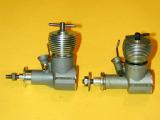 The left side view shows that both are embossed with "ELFIN", though the original also has "made in England" on the case underside. The venturi on the original is higher and the rounded nose of the lugs on the repro is apparent. Notice also the thin washer behind the prop driver of the original to take up excess end-play and the different threads for the prop nut.
The left side view shows that both are embossed with "ELFIN", though the original also has "made in England" on the case underside. The venturi on the original is higher and the rounded nose of the lugs on the repro is apparent. Notice also the thin washer behind the prop driver of the original to take up excess end-play and the different threads for the prop nut.
Design:
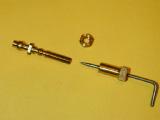 A strange design detail change on both the Russian repro and Ivor's repros is the spherical bubble centered over the jet hole in the spraybar. In effect, the spraybar diameter has been reduced either side of the jet quite deliberately resulting in an extra restriction of the venturi about the jet. There does not seem to be a noticeable difference in the venturi diameter between the engines, so I've queried David Owen to find out what Ivor and Gordon Burford (who consulted on the design) were on about here. More when I know...
A strange design detail change on both the Russian repro and Ivor's repros is the spherical bubble centered over the jet hole in the spraybar. In effect, the spraybar diameter has been reduced either side of the jet quite deliberately resulting in an extra restriction of the venturi about the jet. There does not seem to be a noticeable difference in the venturi diameter between the engines, so I've queried David Owen to find out what Ivor and Gordon Burford (who consulted on the design) were on about here. More when I know...
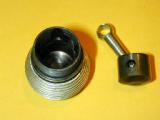 Finally, here's a picture of the piston shape and porting (original engine). Note the flattened cone deflector top on the piston and the four milled transfer passages that end just below the exhaust band. This arrangement (sometimes called Arden porting) became quite popular on British peripheral ported designs. It requires the piston to travel considerably below the exhaust ports to uncover the transfer passages. The diametrally opposed passages are also a risk to the free floating wrist pin mentioned earlier--it's all luck of the draw where they end up in relation to the pin axis when the cylinder is tightened. The staking of the wrist pin in the repro is a much safer arrangement. The purpose of the coned piston crown was to encourage the new charge to travel up the center of the bore to improve scavenging. By most reports, flat top pistons produced the same power and economy, so this refinement is of questionable efficacy--in fact, several manufacturers dropped the idea in later marks of the same engine (ED, for example on the ED Baby, and Dennis Allen on the AM range).
Finally, here's a picture of the piston shape and porting (original engine). Note the flattened cone deflector top on the piston and the four milled transfer passages that end just below the exhaust band. This arrangement (sometimes called Arden porting) became quite popular on British peripheral ported designs. It requires the piston to travel considerably below the exhaust ports to uncover the transfer passages. The diametrally opposed passages are also a risk to the free floating wrist pin mentioned earlier--it's all luck of the draw where they end up in relation to the pin axis when the cylinder is tightened. The staking of the wrist pin in the repro is a much safer arrangement. The purpose of the coned piston crown was to encourage the new charge to travel up the center of the bore to improve scavenging. By most reports, flat top pistons produced the same power and economy, so this refinement is of questionable efficacy--in fact, several manufacturers dropped the idea in later marks of the same engine (ED, for example on the ED Baby, and Dennis Allen on the AM range).
 Just when I thought it was all settled, Ken Croft sent a picture of two definitely genuine Aerol Elfin 149's with eight fins--or perhaps six, depending on how you count them! Well, these things can happen during a long-ish production run. There's also some question regarding my "genuine" Elfin too as the Motor Boys (and I) agree it seems to have a PAW needle--identifiable by the characteristic hex section on the end of the thimble--with a piano wire "clicker" that is correct for the Elfin thimble, but useless on the PAW. And although the case is new, all other Aerol Elfins we have encountered have a shiny, as cast finish. Mine has obviously been blasted to a matt finish, although the die flashing has not been removed.
Just when I thought it was all settled, Ken Croft sent a picture of two definitely genuine Aerol Elfin 149's with eight fins--or perhaps six, depending on how you count them! Well, these things can happen during a long-ish production run. There's also some question regarding my "genuine" Elfin too as the Motor Boys (and I) agree it seems to have a PAW needle--identifiable by the characteristic hex section on the end of the thimble--with a piano wire "clicker" that is correct for the Elfin thimble, but useless on the PAW. And although the case is new, all other Aerol Elfins we have encountered have a shiny, as cast finish. Mine has obviously been blasted to a matt finish, although the die flashing has not been removed.
Conclusion:
An original can be easily distinguished from a repro by the crankcase differences. But placing an original within the production span is difficult. The engine reviewed by Sparey in 1950 clearly has 13 fins. So does my example but Ken's engines show fewer fins, some variation of the thickness of the upper fin, and a "V" shaped comp screw. All Elfin engines had bright cases, but my NIB engine has a "blasted" case. It also has a 'wrong' needle in a correct spraybar, with (perhaps) a year of manufacture indicator after Aerol closed down. Very strange... Based on the evidence, one conclusion would be that it was assembled from Aerol inventory parts, supplemented as required by other bits after normal production ceased, perhaps using cases with cosmetic defects that required blasting to cover them up.
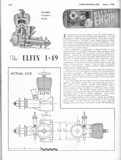 |
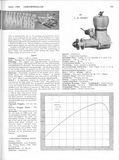 |
References:
| [1] | Sparey, LH: Engine Analysis No. 24: Elfin 1.49, Aeromodeller, Volume XV, Number 173, June 1950, p372. |
| [2] | anon: Engine Review: Elfin 1.49, Model Aviation, Volume 8, Number 112, August 1950, p382. |
| [3] | Fisher, OFW: Collector's Guide to Model Aero Engines, Argus Books, Watford, 1977, p39. |
Back to the Model Engine News Home Page
